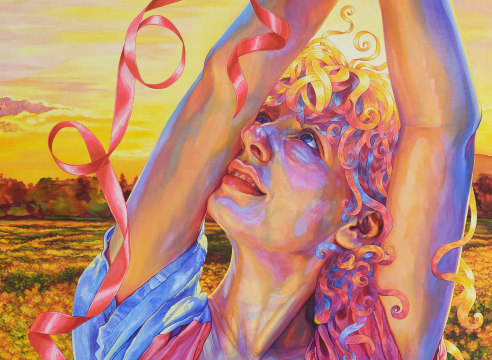
Fredericks & Freiser is pleased to announce Hannah Lupton Reinhard’s debut New York solo show, Shekinah, Shiksas, and Other Nice Jewish Girls. Drawing from her Jewish upbringing and ever-changing relationship to the religion, Lupton Reinhard brings a contemporary feminine sensibility to ritual and biblical narrative. According to Kabbalistic lore, the universe took its shape after vessels filled with the light of God had been shattered—scattering the shards through every inch of the world. Shekinah is that divine feminine light that dwells among us and in us. Lupton Reinhard gathers these sparks of creation in paintings that vibrate with magical intensity, from every eyelash to every blade of grass to every rhinestone.
In these portraits of her Jewish and gentile friends, “Shiksa,” Yiddish slang for a non-Jewish woman, is reclaimed as a term of endearment and expands a community past bloodlines or national belonging. Blending portraiture with generalized figuration, Lupton Reinhard’s friends and sisters become characters in a play spanning Biblical times, the Renaissance, the modern day, and a possible future. Tambourines become halos of fallen angels, butterflies become ghosts of those we have lost, and headscarves become tokens of modesty—all while Sodom and Gomorrah burn behind us.
With loss, however, comes rebirth and springtime, and catastrophe demands a new covenant with color. Rejecting the neutrality of ash, bone, and beige, Lupton Reinhard applies oil paint like watercolor in a buildup of transparent layers, resulting in a hyper-saturated, luminescent coloration. Finally, the paintings are adorned with a Pointillist application of Swarovski crystals, creating unexpected moments of light and texture that dissolve the boundary between the real and unreal.
Stylized hair, girly dresses, butterflies, and literal sparkles give the work a hyper-feminine impression. But upon further inspection, their sadness, lack of grace, and overwrought qualities become undeniable. The figures’ hair, which feels heavy and overworked, mimics movement, without really depicting it. Their hands and feet are chunky and awkward, calling into question the daintiness we often associate with beauty. And each rhinestone is applied individually, demanding that we acknowledge the absurdity of laborious craft. The paintings’ desire to be seen as beautiful becomes almost obsessive, reflecting a feminine self-consciousness. Although they fear not being loved, they refuse to make themselves small. “Hineini,” they shout. “Here I am!”